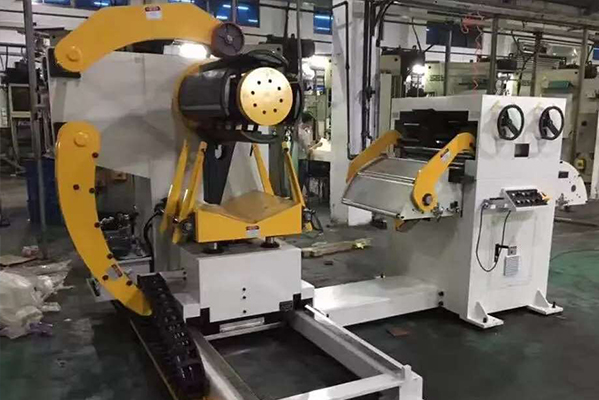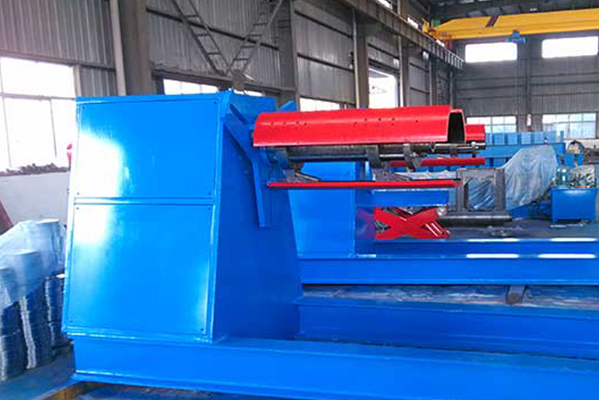Navigation Menu
Contact Us
- Email:
- info@wxavatar.com
- Address:
- Yurong Village, Yuqi Street, Huishan District, Wuxi, China.
Release Date:Mar 21, 2025 Visit:41 Source:Roll Forming Machine Factory
Using a 10-ton hydraulic uncoiler involves significant risks due to its heavy load capacity, high-pressure hydraulic systems, and mechanical complexity. Below are the key dangers to be aware of, along with real-world examples of potential accidents:
1. Mechanical Hazards
Crushing Injuries:
Heavy coils (up to 10 tons) can shift or fall during loading/unloading, crushing limbs or causing fatalities.
Example: A misaligned coil slipping off the mandrel could trap an operator.
Pinch Points:
Moving parts like rollers, mandrels, or guide arms pose entanglement or amputation risks.
Example: Loose clothing or gloves caught in rotating components.
2. Hydraulic System Failures
High-Pressure Fluid Leaks:
Hydraulic hoses or seals bursting under pressure can spray hot, flammable oil, causing burns, fires, or slips.
Example: A ruptured hydraulic line spraying fluid near an electrical panel could ignite.
Sudden Release of Stored Energy:
Hydraulic systems retain pressure even when powered off. Improper maintenance (e.g., bleeding pressure) risks explosive component failure.

3. Material Handling Risks
Coil Whiplash:
A poorly secured coil unwinding unevenly can snap or whip metal strips at high speed, causing severe lacerations.
Example: A loose coil end striking an operator during rapid unwinding.
Flying Debris:
Metal burrs, broken bolts, or fragmented components can become projectiles during malfunctions.
4. Electrical Hazards
Electrocution:
Faulty wiring in motors, PLCs, or frequency inverters can expose operators to live circuits.
Example: Water ingress into electrical panels causing short circuits.
5. Ergonomic and Environmental Risks
Musculoskeletal Injuries:
Manual handling of heavy coil ends or components without proper lifting equipment strains muscles.
Noise-Induced Hearing Loss:
Hydraulic pumps and metal-on-metal contact generate noise exceeding 85 dB, requiring hearing protection.
Hydraulic Oil Contamination:
Spilled oil creates slippery floors, and improper disposal harms the environment.
6. Operational Errors
Overloading:
Exceeding the 10-ton capacity stresses the frame, risking catastrophic structural failure.
Improper Speed/Tension Settings:
Mismatched unwinding speed or tension can snap metal strips, damage downstream machinery, or cause jams.
7. Fire and Explosion Risks
Hydraulic Fluid Flammability:
Leaks near hot machinery or sparks (e.g., welding) can ignite hydraulic oil.
Dust Combustion:
Metal dust in processing areas (e.g., from grinding) may combust under certain conditions.
Prevention and Mitigation Strategies
1.Safety Training:
Train operators on lockout/tagout (LOTO), emergency stops, and hazard recognition.
2.Regular Maintenance:
Inspect hydraulic lines, seals, and electrical systems weekly. Replace worn parts immediately.
3.PPE Requirements:
Mandate steel-toe boots, gloves, safety glasses, and hearing protection.
4.Load Management:
Use cranes/coil cars for loading; never manually position 10-ton coils.
5.Pressure Relief:
Always depressurize hydraulic systems before repairs.
6.Guarding:
Install physical guards around pinch points and rotating parts.
7.Environmental Controls:
Use drip trays for hydraulic oil and enforce strict disposal protocols.

Real-World Accident Scenarios
Case 1: An untrained operator attempted to adjust a misaligned coil while the uncoiler was running, resulting in a severed finger from the mandrel.
Case 2: A hydraulic hose failure caused hot oil to spray onto a nearby worker, leading to second-degree burns.
Case 3: Overloading the uncoiler beyond 10 tons cracked the frame, causing the coil to collapse and damage adjacent machinery.
Conclusion
The dangers of a 10-ton hydraulic uncoiler stem from heavy loads, high-pressure systems, and human error. Mitigating these risks requires strict adherence to safety protocols, routine maintenance, and comprehensive operator training. Always consult the manufacturer’s guidelines (e.g., Liming Machinery or Wuxi Wuye Heavy Industry) and prioritize safety over speed in operations.